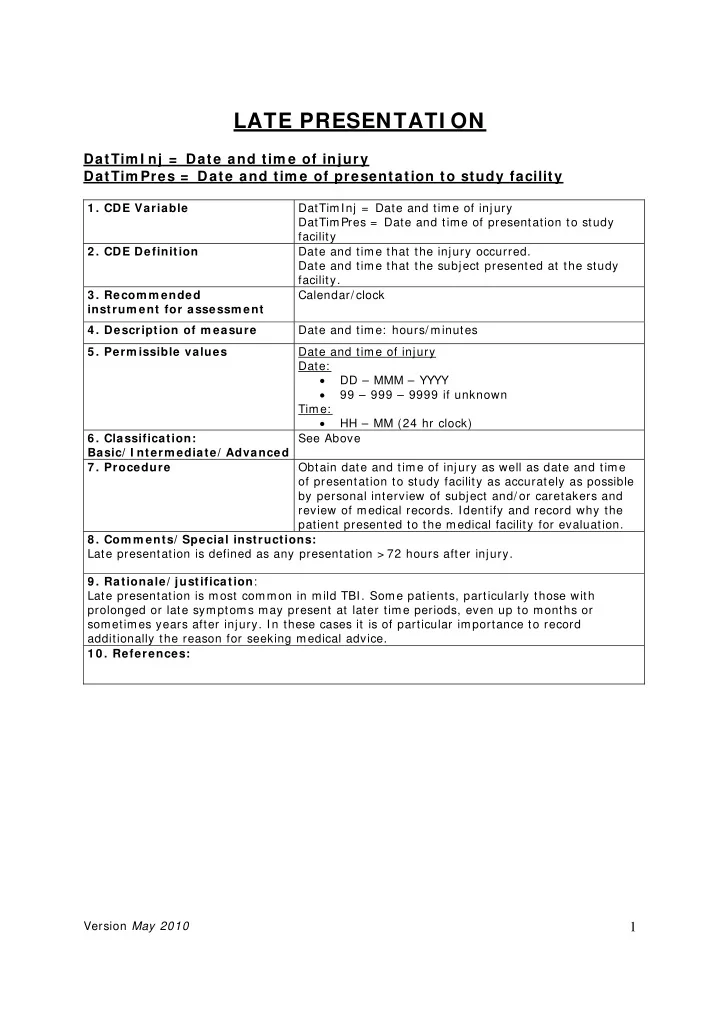

LATE PRESENTATI ON DatTim I nj = Date and tim e of injury DatTim Pres = Date and tim e of presentation to study facility 1 . CDE Variable DatTimInj = Date and time of injury DatTimPres = Date and time of presentation to study facility 2 . CDE Definition Date and time that the injury occurred. Date and time that the subject presented at the study facility. 3 . Recom m ended Calendar/ clock instrum ent for assessm ent 4 . Description of m easure Date and time: hours/ minutes 5 . Perm issible values Date and time of injury Date: DD – MMM – YYYY 99 – 999 – 9999 if unknown Time: HH – MM (24 hr clock) 6 . Classification: See Above Basic/ I nterm ediate/ Advanced 7 . Procedure Obtain date and time of injury as well as date and time of presentation to study facility as accurately as possible by personal interview of subject and/ or caretakers and review of medical records. Identify and record why the patient presented to the medical facility for evaluation. 8 . Com m ents/ Special instructions: Late presentation is defined as any presentation > 72 hours after injury. 9 . Rationale/ justification : Late presentation is most common in mild TBI. Some patients, particularly those with prolonged or late symptoms may present at later time periods, even up to months or sometimes years after injury. In these cases it is of particular importance to record additionally the reason for seeking medical advice. 1 0. References: Version May 2010 1
LATE PRESENTATI ON PresReason = Reason for presentation 1 . CDE Variable PresReason = Reason for presentation at study facility. 2 . CDE Definition Reason for presentation: reason for interface with medical provider. 3 . Recom m ended N/ A instrum ent for assessm ent 4 . Description of m easure Categorical; unique entry. 5 . Perm issible values Reason for presentation: Basic Intermediate/ Advanced Self referral with Self referral with complaints complaints On advice significant On advice significant other other Routine screening Routine screening Repatriation Repatriation Professional referral Professional referral GP Hospital Other caretaker 6 . Classification: Reason for presentation: basic and Basic/ I nterm ediate/ Advanced intermediate/ advanced 7 . Procedure Self report, interview of care takers, medical record. Identify and record why the patient presented to the medical facility for evaluation. 8 . Com m ents/ Special instructions: Mild TBI may not be detected in patients without systematic clinical assessment. It is thought to be overreported in individuals with possible financial gain; it is thought to be underreported in individuals highly motivated to return to teamplay, work, or to support military operations. 9 . Rationale/ justification: Provides information on the setting in which the patient was seen upon late presentation; information on initial care is important as this may affect outcome and be associated with injury severity. Reason for presentation important for later determination of population captured. 1 0. References: Moss NE, Wade DT. Admission after head injury: how many occur and how many are recorded? Injury . Apr 1996; 27(3): 159-161 Version May 2010 2
LATE PRESENTATI ON I nitMedCar = I nitial m edical care directly after injury I nitMedProv = Provider of initial m edical care directly after injury I nitMedType = Type of initial care provided 1 . CDE Variable InitMedCar = Initial medical care directly after injury InitMedProv = Provider of initial medical care directly after injury InitMedType = Type of initial care provided 2 . CDE Definition Details on initial medical care directly after injury, differentiated for setting, provider and type of initial care provided. 3 . Recom m ended N/ A instrum ent for assessm ent 4 . Description of m easure Categorical; multiple entries permitted 5 . Perm issible values Initial medical care directly after injury: yes/ no/ unknown Provider: Bystander Trainer/ coach Medic Emergency department Physician Other Type of initial care provided: Education about course of symptoms CT/ MRI Hospitalization Specialized therapies (speech, physical, occupational therapy) Evaluations (neurological; psychological) Medication Other 6 . Classification: Basic: setting Basic/ I nterm ediate/ Advanced Intermediate/ Advanced: include information on provider and type of initial care 7 . Procedure Self report, interview of care takers, medical record. Document details on the initial medical care directly after injury. 8 . Com m ents/ Special instructions: Mild TBI may not be detected in patients without systematic clinical assessment. It is thought to be overreported in individuals with possible financial gain; it is thought to be underreported in individuals highly motivated to return to teamplay, work, or to support military operations. 9 . Rationale/ justification: Information on initial medical care is important as this may affect outcome and be associated with injury severity. 1 0. References: N.E.G. Moss and D.T. Wade , Neuropsychological studies of poor effort Version May 2010 3
Recommend
More recommend